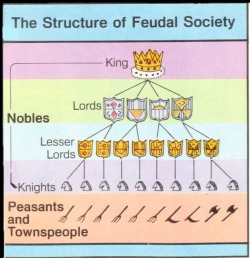The Development of Feudalism
Life in Europe during the middle ages a web of relationships based on duties and responsibilities. This system developed in response to attacks from outsiders. Nobles found that they could not rely on the kings or royalty for protection, and to keep there lands safe. To do this the nobles established relationships with knights. Nobles gave plots of land called fiefs to the knights. In return the knights would have to promise to help their noble when in defense or attack. In this way a noble would be called a lord, and the knight would be called a vassal. The vassals also had to give the noble a place to sleep and give them some of their crops if they came to visit. And if the vassals were in need of it, the lords would send soldiers to help defend an attack towards the knights. So either way both people helped each other. Feudalism was the name this network of duties and responsibilities between lords and vassals. The medieval society had many layers. At the top were kings and queens. Nobles were their vassals, then came knights who served their lords and nobles. Knights could also have peasants work on their land and grow some of their crops while they were doing something else or working with the lord. So people could be lords and vassals. Peasants were at the bottom of the chain. They owned no land and had very few rights. People had responsibilities, to those below them and duties to those above them. This system was a new start for a new kind of social and political order that replaced the Roman Empire.
This here is a picture of the structure of the feudal society. The kings are at the top meaning that they are the most important. Then below them are the lords that would lend their land to the knights in the manor system. Then there are the lesser lords that are not as powerful. Then come the knights who helped the lords in battle. And lastly there are the peasants and townspeople who were not important at all to the feudal society.

